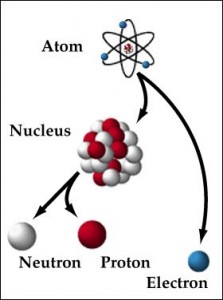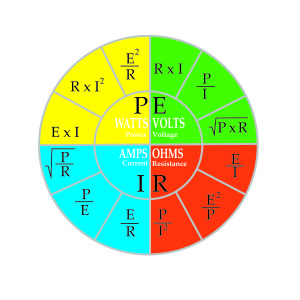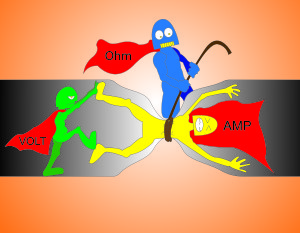Electricity is created by electrons in an atom being pushed from one atom to the next. The atom consists of three parts:
- The Neutron
- The Proton
- The Electron
The neutron and proton form the nucleus or center of the atom. The electrons orbit around the nucleus. Each material has different number of electrons orbiting around the nucleus. The pushing of these electrons is measured in volts. The faster the pushing of these electrons, the higher the voltage. Some materials allow their electrons to be pushed more freely than others. Gold, Silver, Copper, Aluminum are good conductors because they have the ability to allow their electrons to be pushed freely from one atom to the next.
Other materials are more resistant to allow electrons to be pushed from one atom to the next. For example paper, glass, and plastic have a outer orbit of electrons that are fuller and resist the pushing of electrons from one atom to the next.
Ohm’s Law
Ohm’s Law is one of the most important and fundamental tools to be used through out a electrical career. By understanding Ohm’s Law it can make a electrician work easier and faster. It is a mathematical tool which is of the greatest use in determining an unknown factor of voltage , current or resistance in an electrical circuit in which the other two factors are known. It is a simple law that states the relationship between voltage, current and resistance.
Ohms Law may be divided into four elements:
- (P) Watts
- (E) Voltage
- (I) Amperage
- (R) Ohms
Power: The rate at which electrical energy is delivered and consumed. Power is measured in watts. A motor produces mechanical power measured in horsepower. A heater produces heat (thermal) power. A light bulb produces both heat and light power.
Voltage: The practical unit of voltage; the pressure required to force one ampere through a resistance of one ohm. To make electrons flow in a conductor, an electrical pressure must be applied and this is called electromotive force(EMF) or voltage.
Ampere: The practical unit of electric current flow; the electric current that will flow through one ohm under pressure of one volt. The rate of flow of electrons through a conductor is called current. Current is measured in amperes or amps. The term ampere refers to the number of electrons passing a given point in one second.
Resistance: The opposition to the flow of electrons (current). Resistance is measured in ohms. The Greek symbol Ω (omega) is often used to represent ohms.



